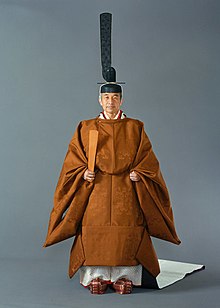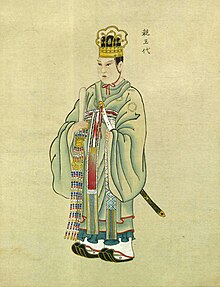Kanmuri (headwear)
It was the standard headwear worn by adult men at the Japanese imperial court, including courtiers, aristocrats, and the emperor, from the Heian period to the Meiji Restoration.
Today, it is worn only by the Imperial Family and government officials on rare occasions, such as weddings and the accession of new emperors.
[1] At the back of the kanmuri is a long, thin silk ornament called ei (纓), which is a variation of string.
Types of kanmuri generally differ in the shape of the ei and the textile pattern, and also according to the rank of the person.
Gradually, however, it came to refer primarily to the lacquer-fastened cloth headwear worn by the nobility with their court dress (sokutai).
As accessories, there is a string called ageo (上緒) that hangs at the base of the koji, and a hairpin that pierces the topknot and holds it in place.
In the Chinese history book Sanguozhi (The Records of the Three Kingdoms), "Wajinden" (Treatise on the Wa People) describes that Japanese men wore nothing but a paper mulberry cloth around their heads, suggesting that there were still no crowns in Japan during the Yayoi period but something similar to hachimaki (Japanese headband).
The official association of status with the kanmuri in Japan began with the establishment of the Twelve Level Cap and Rank System in 603.
The crowns were made of brocade or patterned cloth, and were further adorned with gold or silver floral ornaments.
"[4][a] The Tenjukoku Shūchō Mandala (622), which is said to have been produced under the guidance of Prince Shōtoku's wife, shows that the kanmuri at that time was like a silk cap, with colors such as red, blue, black, and purple corresponding to the official rank.
The direct origin of the kanmuri in Japan is believed to be the tokin (頭巾), which was worn when wearing court dress (朝服), as established in the clothing ordinance of the Yōrō Code.
[9] In the Edo period (1603-1867), a new kanmuri called Go-Ryūei (御立纓) was introduced exclusively for the emperor, in which the ei stands upright.
[10] After the Meiji Restoration, the use of kanmuri declined dramatically as the formal dress of the Japanese nobility became Western-style.





